April Fool's TenSpot: Top Ten Final Fantasy Games
We take a look back at all of the Final Fantasy games and select, in order, the ten best ones. Of course, it was all just a joke.
Final Fantasy Forever
Happy April Fool's Day Folks!
On Saturday, April 1st, 2006, instead of posting a regular Saturday feature, the staff here at GameSpot decided to take advantage of the fortuitous timing and play a little April Fool's joke on you all.
Some of you fell for it, some of you didn't, and a LOT of people voted for their own favorite Final Fantasy, either playing along with our joke, or submitting their own serious entry.
So thank you all for being good sports, and giving us a little chuckle. We'll keep this around for posterity, but clearly label it as an April Fool's joke. And who knows, maybe we'll resurface the feature "for real" sometime soon?
--Carrie Gouskos, Features Editor
Final Fantasy is one of those franchises that seems to get everyone excited. Throughout the last 20 years there have been a ton of Final Fantasy games released over a number of different systems, although admittedly none of them were ever really final. In the wake of the recent release of Final Fantasy XII in Japan and anticipation of its release over here, the GameSpot editors sat down and outlined their picks for the Top 10 Final Fantasy Games of All Time. It is truly amazing that a series is responsible for so many great games even worthy of an argument for a top 10, but arguments there were a-plenty.
The picks range from the obvious to the not-so-obvious and are in exact order from the 10th pick to the top pick. After reading through our choices, you can sound off on yours by either selecting one of the games from the drop-down box or writing in your own submission into the blank field. So what are you waiting for? Bust out your gunblade and your handkerchiefs and get ready for a sure-to-be-sappy nostalgiafest of the Top 10 Final Fantasy Games of All Time.
Square's SaGa series has gone on to earn a name for itself in its own right, but that's because not enough people remember its humble roots as part of the Final Fantasy canon. Starting off as the Final Fantasy Legend games on the Game Boy, the SaGa games managed to be wildly different than the traditional console Final Fantasies but still capture some of what is so great about the series.
Final Fantasy Legend was released in 1989, offering up the very best turn-based role-playing game on the system to that date. Choosing between eight character classes, players guide the four main characters through a massive world and a number of intricately crafted dungeons to find the tower that leads to paradise. The enemy encounters were randomly generated, a trend that had started in RPGs over a decade earlier, but the random encounters in Final Fantasy Legend were particularly well implemented. In fact, there probably hasn't been a game since to exercise that mechanic so well.

Despite being monochrome, Final Fantasy Legend offered some of the best graphics the series has ever seen. The minimalist backgrounds seen during the fight sequences are reminiscent of a Mark Rothko painting, using the fewest strokes (or pixels in this case) to drive the point home. And though the game received a graphical update when it was released on the Wonder Swan Color, it was the appearance of the original game that was really quite so remarkable.
But Final Fantasy Legend also had the gameplay to back up those stellar graphics. Players could pick between three character races, mutants, monsters, and the uniquely conceived humans, and then level up their strength, agility, hit points, and mana accordingly. The mechanics of this system are traditionally RPG but were executed flawlessly on this tiny system. As you embark on your quest to locate paradise, you must find the King's sword, shield, and armor, which will help you get there. Though there have been many Final Fantasy games before and after Final Fantasy Legend, this unique little Game Boy adventure definitely remains one of the series' strongest.
Nintendo fans went a decade without a Final Fantasy game to their home consoles, even despite the fact that the series was born on the Nintendo Entertainment System, so you must imagine their resounding glee to discover that Crystal Chronicles, which ended up being the best Final Fantasy game in recent years, was making its way exclusively to the GameCube.
What is so remarkable about Crystal Chronicles is that unlike other Final Fantasy games that clutch to the series' trademarks with an almost upsetting fervor, this game goes out of its way to make the experience as unique and interesting as possible. A hack-and-slash RPG that borrows more from Diablo than it does from other games in the canon, Crystal Chronicles only beckons the most devoted of Final Fantasy fans by requiring them to buy a whole bunch of other equipment to enjoy the multiplayer experience. I mean, the mere fact that this game even has multiplayer is revolutionary in and of itself. No more sitting at home alone and crying into your pillow about how you'll never get to be with Rinoa! Now you've got to man up and play your Final Fantasy game in front of other people!

You see, to play Crystal Chronicles with four people, you'll need four Game Boy Advances and four GBA-to-GameCube connector cables. You can't get by with just using the normal controllers, oh no. One can imagine that this paved the way for the controller mechanics of the upcoming Nintendo Revolution. The Nintendo executives must have been sitting around patting themselves on the back for conceiving of the multiplayer mechanics in Crystal Chronicles, which clearly made the game superior to many other recent Final Fantasy games (in your face Sony!) and then the Revolution-controller idea happened. It's surprising, actually, that they're not marketing the controller as a separate device (like the GBA) and charging over $100 for it, because people would obviously pay it, and they would be justified in doing so if the quality and ingenuity of Crystal Chronicles is indicative of anything.
Moogles and chocobos may be the animal stars of the Final Fantasy series, but Final Fantasy VIII earns a spot in our list because it calls attention to the large collection of unsung heroes deserving of adoration: the monster summons. For far too long have mighty Bahamut, faithful Odin, and the icy Shiva toiled in thankless service to a rag-tag group of adventurers.
These summoned creatures used to be nothing more than high-powered spells with fancy animations. Bahamut is an impressive-looking dragon, but you could easily replace him with a few sprite effects in older Final Fantasy games since his summon was equivalent to a powerful fire spell. Final Fantasy VIII gave the summoned creatures new powers and intertwined their abilities with character development.
Summoned monsters could earn experience points, level up, and learn new abilities just like party members. Additionally, the new "compatibility" setting required characters to lavish attention on their summoned creatures to keep them happy and performing at top levels. It was a huge step forward toward equality for all summoned-kind. In light of these changes, the creatures discarded the subservient shackles associated with the "summoned" moniker and took on the title of "guardian forces" to shed the decidedly unflattering enslaved-pet image and promote its new benevolent protector status.
Emboldened with new powers, the guardian forces in Final Fantasy VIII dominated fight sequences with majestic entrances and devastating attacks. Behold the power of Shiva's Diamond Dust attack.

When Squall calls on Shiva to help in battle, four green spheres rotate around Squall's head and fly off out of the picture. Then four blue spheres come back into view and spiral down together leaving trails and sparkles in their wake. The spheres coalesce and penetrate the ground to create an icy patch upon the earth. A giant ice crystal rises violently out of the spot, and we see Shiva encased in the crystal--eyes closed, arms crossed downward over her chest.
She opens her eyes and breaks out of the ice just by tossing her hair. The camera rotates around the scantily-clad Shiva; her strategically placed coverings could be mistaken for body paint or variations in skin color. Distracted players fail to notice her gathering energy as she arches her back while raising her hands over her head. She then throws her hands forward to unleash the cold energy blast that transforms the ground beneath the enemy into a frozen landscape that shatters and sends shards of diamond-dust shrapnel into the unsuspecting enemy. If the enemy survives, Squall can call on Shiva again and treat us to another spectacular guardian-force animation sequence.
If there's anything that the Final Fantasy games are known for, it's being long and really difficult. So when Mystic Quest arrived on the SNES and was much easier than previous games, some people didn't know how to handle it. Those people are jerks. Mystic Quest is revolutionary because it opened up the Final Fantasy series (and console RPGs in general) to an audience that was put off by the difficulty of the other games.
As the best Final Fantasy game to grace the SNES, Mystic Quest maintained all of the great elements of the previous games in the series, while making them a lot more palatable for regular players. For example, Mystic Quest reminds you that random encounters are really annoying, and for that matter, quite illogical. Whoever heard of walking around an open environment and then monsters appearing from somewhere where there previously weren't any monsters? Not Mystic Quest. And as for wide-open environments? Mystic Quest wasn't having it. You were given a very specific route to take through the main overworld, which face it, is all you really want to do when you're playing a game anyway. All this randomness and wandering around can just confuse a person.

Mystic Quest was so good that it was even one of the first Final Fantasy games brought to Europe, because European players have refined tastes and know a good Final Fantasy when they see one. And, if it weren't obvious by looking at some of the game's screenshots, Mystic Quest was also a fantastic looking game. The environments maintained a sort of uniform color to them, really giving you the feeling that you're trapped in this desolate world (Earth). The story also drove this point home, not bothering with any of the ridiculously weaving plots of other Final Fantasy games and sticking to the very basic hero-to-save-the-world plot. It's unfortunate that no game has really ever been like Mystic Quest since, because its visionary mechanics would have improved the many Final Fantasy games that have come out since its release.
Ehrgeiz might not be a tried and true Final Fantasy game, but it has everything that's good about Final Fantasy games without all of that excess grinding-RPG nonsense. With insight into a future laden with game crossovers, merchandise, and movies based on the games, Squaresoft lent some of their biggest names to this underappreciated fighter. What they got in return was one of the best experiences that the Final Fantasy characters had to offer and an entirely novel way to do it.
In Ehrgeiz, you're able to combat against Final Fantasy characters in a number of arena environments. Though the characters have been stripped of their natural surroundings, Ehrgeiz lets you engage in a pretty Final Fantasy-rich storyline for a fighting game. In fact, it can possibly be said that it does a better job with the Final Fantasy-type story than many of the full-blown console games. Set in a dystopic future, players aim to seek control of the Ehrgeiz, a materia-infused enchanted sword. Using combat elements that combine the best aspects of wrestling games and PlayStation blockbuster Tobal, Ehrgeiz is one of the best fighting games on any system to date.

But the best thing about Final Fantasy Fighter, or Ehrgeiz, is the character roster. Making appearances in this game are Cloud, Tifa, Yuffie, Zack, Vincent, and Sephiroth, and quite frankly, it is their implementation in Ehrgeiz that makes them so memorable. Characters such as Sephiroth clearly wouldn't have remained so iconic, even now, if it weren't for Ehrgeiz. The fighter Sephiroth is one you've never seen before, and you're able to get down and dirty with him, a luxury of interaction that can't be outmatched by his appearances in any other game or property. Combining great fighting mechanics and what might be considered the best use of Final Fantasy characters ever seen, Ehrgeiz is a masterful blend of Final Fantasy personality and gameplay that is actually fun, unlike so many other Final Fantasy games.
We've already mentioned the original SaGa game, or Final Fantasy Legend for the Game Boy, but it was Final Fantasy Legend II that was the highlight of the series. Expanding upon the first game and continuing to beat on its own drum as far as Final Fantasy gameplay goes, Legend II offers up the story and graphics unparalleled by virtually every other game in the series. Once again, paying no heed to other graphically rich games on the Game Boy, such as Alexey Pazhitnov's sleeper hit Tetris, Legend II is both impactful and minimalist at the same time. This paved the way for other games to go with the less-is-more approach. As we've learned far too often, especially within the Final Fantasy series itself, complicated and convoluted graphics and plot do nothing for a game.
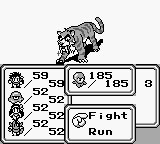
In Final Fantasy Legend II, you are once again able to pick between a number of classes, although an addition to this game from the previous is that you'll be able to play as a robot. Let it be said right here that robots are awesome, and it was the inclusion of the robot class that almost put Final Fantasy Legend II at the top of our list. In fact, consider this secretly tied for first place because you can play as a robot. If more games had robots, maybe there would be more peace in the world. Or maybe everyone should be forced to sit down and play through Final Fantasy Legend II. Either way, robots clearly make Final Fantasy Legend II one of the greatest Final Fantasy games of all time.
In Legend II you come back to fight the demon lord Ashura, as you did in the first game. This kind of consistency is something we've come to expect from Final Fantasy games, a familiarty with the game right from the start. Can you imagine starting out a game that is part of the same series and having it be a whole new world and environment? That seems so completely deceptive and uninteresting. Thankfully, Final Fantasy Legend II isn't misleading like that. The consistency of the story and the inclusion of robots are why Final Fantasy Legend II is so strong and why the game holds up, even today.
The only thing wrong with Final Fantasy VII Snowboarding is that the title is a little misleading. This game, which hit cell phones in the middle of 2005, came out long after Final Fantasy VIII, so it makes little sense that the series is taking a step back and calling it VII. We suspect it has something to do with the naming-convention problems that were incurred when some of the Final Fantasy games were exclusively released over in Japan, causing numerical discrepancies between the two territories. Despite the faulty name, Final Fantasy VII Snowboarding is a thrilling experience that lets you take Cloud Strife out for a spin on a snowboard, melding together the currently hip "extreme sports" genre and Final Fantasy characters effortlessly. Not since his appearance in Ehrgeiz has Cloud Strife seemed so relevant.

This game, which looks fantastic on most mobile phones, fully renders Cloud's token blonde mop and thankfully doesn't cover it up with a pesky snowboarding helmet, although we suppose another downside of this game is that it doesn't preach safe snowboarding. Regardless though, the game is fun and thrilling, and like some of the other games on our list, it offers a new twist to traditional Final Fantasy gameplay. In fact, this is the type of gameplay that could be made into a full console game and would do well with some of the classic RPG stuff, maybe as a minigame or something. That's how compelling Final Fantasy VII Snowboarding is; it outshines all the other elements of traditional Final Fantasy games.
We know that Final Fantasy VIII was already on this list, but it's just so good, we can't help but keep talking about the awesome summons.
Squall calls on Shiva to help in battle once again. Four green spheres rotate around Squall's head and fly out of the picture. Four blue spheres then come back into view and spiral down together, leaving trails and sparkles in their wake. What changed the green spheres into blue, we ponder. But all too soon, the spheres coalesce and penetrate the ground to create a familiar icy patch upon the earth. A giant ice crystal rises violently out of the frozen earth, and we see Shiva encased in the crystal--eyes closed, arms crossed downward over her chest.
She opens her eyes and breaks out of the ice just by tossing her hair. She carries out the action nonchalantly, as if she makes this dramatic entrance all the time. The camera rotates around the scantily-clad Shiva--we can't find any texture differences to indicate that the covered areas are made of skin-tight clothing. She arches her back and raises her hands over her head to gather energy. She then throws her hands forward to unleash the cold energy blast that transforms the ground beneath the enemy into a frozen landscape. The ice shatters and sends shards of diamond-dust shrapnel into the enemy. If the enemy survives, Squall can call on Shiva again and treat us to another spectacular guardian-force animation sequence.
Squall calls on Shiva to help in battle yet again. Four green spheres rotate around Squall's head and fly out of the picture. The green spheres no doubt went to Shiva's home universe where she captured them and washed them blue with an icy stare. Four newly blue spheres come back into view and spiral down together, leaving trails and sparkles in their wake. The spheres fuse and penetrate the ground to create an icy patch upon the earth. Remarkably, the area is completely clean, despite all the previous ice attacks launched on that exact same spot. The familiar giant ice crystal rises violently out of the spot, and we see Shiva encased in the crystal once again--eyes closed, arms crossed downward over her chest. Transmuting spheres must be tiring work.
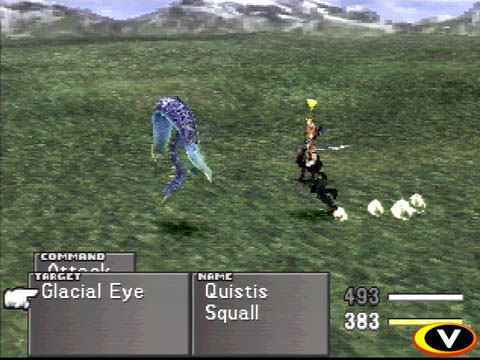
She opens her eyes and breaks out of the ice with a toss of the head, almost flirtatiously this time. The camera rotates around the scantily-clad Shiva. Yes, it has to be body paint. She arches her back and raises her hands over her head to gather energy. She then throws her hands forward to unleash the cold energy blast that transforms the ground beneath the enemy into a frozen landscape that shatters and sends shards of diamond-dust shrapnel into the now weary enemy. If the enemy survives, Squall can call on Shiva again and treat us to another spectacular guardian-force animation sequence.
Final Fantasy VIII detractors often criticize the game's guardian-force animations as boring and maddeningly repetitive. Novice fans defending the game will point out that the guardian-force's boost ability makes the animations interesting because you can press select and hammer the X button to increase the damage done by the guardian force. Expert fanatics, on the other hand, will explain how properly junctioned characters don't even need to use the guardian-force calls late in the game, but true Final Fantasy VIII devotees will denounce such behavior as blasphemy.
Genuine Final Fantasy VIII believers love the fact that the game doesn't let you skip through any part of the guardian-force event sequence. Each guardian-force animation reveals new meaning every time you watch it. The guardian forces show us that repetition and mindful awareness can lead us to enlightenment.
So Final Fantasy: The Spirits Within isn't a game in the "technical" sense. But you know what? Sometimes it's less about the ones and the zeroes and more about heart, soul, and achingly great voice-acting--three things that FF:TSW has in absolute abundance. That's why this CGI excursion into the upper limits of imaginative fiction deserves its place on the top 10 Final Fantasy games list.
Like most Final Fantasy iterations, The Spirit Within takes place within its own separate universe--this time a near-earth version of Earth that has been overrun with strange, ethereal creatures known as "phantoms." Contact with these phantoms is lethal to humans, so the humble remains of Earth's government have sought methods of combating this...wait for it...phantom menace. The first option is a gigantic supercannon orbiting the earth that's ready to blast the phantoms to hell and back; the second is by creating a strange energy wave of an opposite frequency to the ones resonating in the phantoms. The only way to perfect this energy wave is by collecting "spirits," which are found in the small pockets of life that still exist on the Earth. If it sounds like confusing sci-fi mumbo jumbo, trust us, it isn't. This is all perfectly valid scientific theory.

Honestly though, the plot of the movie doesn't matter, especially when you consider the stellar English-language voice cast, comprised of a group of relatively unknown film actors. Alec Baldwin (The Cat in the Hat) stars as Capt. Gray Edwards, a fiery, tough-as-nails badass presiding over a squad of similarly-tough-as-nails-but-also-liable-to-toss-in-a-wisecrack-here-and-there squad of badasses, which is comprised of Sgt. Ryan Walker (Ving Rhames, Striptease) and Officer Neil Fleming (Steve Buscemi, Spy Kids 2: Island of Lost Dreams, Spy Kids 3-D: Game Over). The science team is headed by Donald Sutherland's (The Poky Little Puppy's First Christmas) soft-spoken but fiery Dr. Cid, and the film's central character, fiery Dr. Aki Ross, is voiced to utter perfection by Ming-Na (Mulan II).
Much was initially made of The Spirits Within's CGI look, and even now, five years after it was initially released, the movie's characters and settings are just as impressive as they were back then. In fact, we believe this is exactly how the world will look in the year 2065, complete with everyone having huge numbers of moles on their neck and head and freckles everywhere, just like in the movie. There will be a freckles epidemic in 2065. Watch and see.
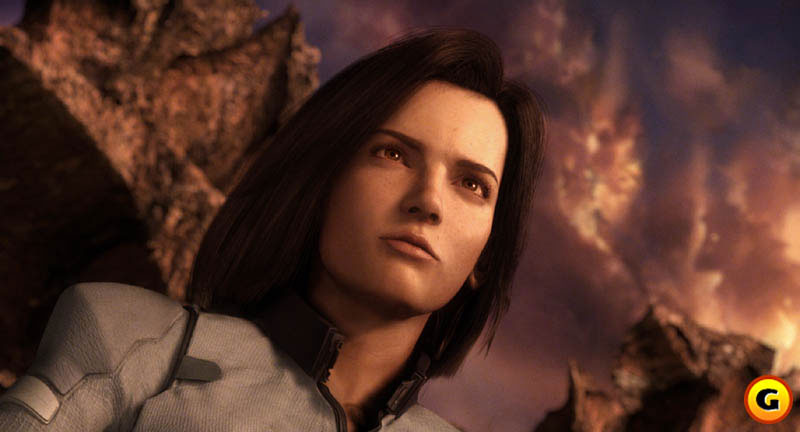
The Spirits Within is obviously the wellspring from which all CGI movies since have sprung. In fact, heartened by the movie's incredible box-office success in 2001, Square Pictures found the guts to take their CGI prowess to another Final Fantasy film project, reviving the little-known seventh Final Fantasy game into a full-length feature film, Final Fantasy VII: Advent Children. Here's hoping this film helps FFVII gain the attention that the sadly overlooked game deserves.
In summary, we wish we had the power to grow extra appendages, because then we could give Final Fantasy: The Spirits Within three thumbs up. You can find The Spirits Within on DVD, which in some ways makes this film the best kind of game--the kind where you only have to press one button. And that button is "play."
The Final Fantasy series mostly sticks to the core, numbered games. But over the years, there have been plenty of diversions. From Chocobo Racing for the PlayStation to Mystic Quest, there have been plenty of games to exist outside of the Final Fantasy "canon." And one of the first was definitely one of the best. Dragon Warrior is a little-known role-playing game for the Nintendo Entertainment System, an "8-bit" console machine that surfaced back in the mid-1980s. Though not many people got a chance to play Dragon Warrior due to it being on a relatively obscure platform, the game made several interesting changes to the Final Fantasy formula. Rather than having you build a party of multiple characters, Dragon Warrior focused on one character. To make up for this obvious deficiency, the character was multiclass, combining the skills of a fighter with some white-mage healing and plenty of black-mage combat spells. So your little guy could definitely fend for himself.
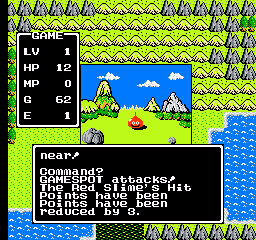
Like most other Final Fantasy games, Dragon Warriors is filled with plenty of lengthy, story-driven sequences as you attempt to save the world from ultimate evil. But unlike the rest of the games in the series, none of those sequences came up in combat. No awesome monster-summon animations, no nothing. Omissions like this are probably what led to the game being overlooked by many of the series' "hardcore" fans.
Many of the monsters you'd face in the game were completely different from the stuff you'd find in the rest of the Final Fantasy line. Most of them are pretty forgettable, save for a little slime-like creature that you'd fight early on in the game. Also, movement in the game is pretty slow, making it all the more surprising that the game completely lacks chocobos. But both in spite of and because of the numerous changes Dragon Warrior makes to the Final Fantasy formula, it definitely stands the test of time and stands out easily as one of the greatest Final Fantasy games ever made. Though, yeah, more summons would have probably helped.
Got a news tip or want to contact us directly? Email news@gamespot.com



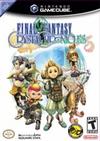
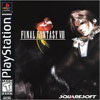

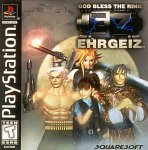



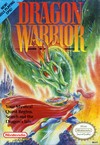
Join the conversation